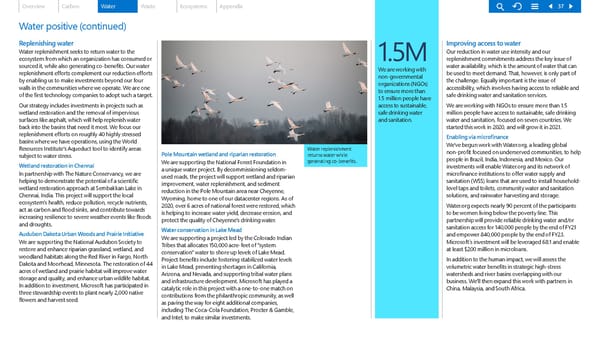Overview Carbon Water Waste Ecosystems Appendix 37 Water positive (continued) Replenishing water Improving access to water Water replenishment seeks to return water to the Our reduction in water use intensity and our ecosystem from which an organization has consumed or 1.5M replenishment commitments address the key issue of sourced it, while also generating co-benefits. Our water We are working with water availability, which is the amount of water that can replenishment efforts complement our reduction efforts non-governmental be used to meet demand. That, however, is only part of by enabling us to make investments beyond our four organizations (NGOs) the challenge. Equally important is the issue of walls in the communities where we operate. We are one to ensure more than accessibility, which involves having access to reliable and of the first technology companies to adopt such a target. 1.5 million people have safe drinking water and sanitation services. Our strategy includes investments in projects such as access to sustainable, We are working with NGOs to ensure more than 1.5 wetland restoration and the removal of impervious safe drinking water million people have access to sustainable, safe drinking surfaces like asphalt, which will help replenish water and sanitation. water and sanitation, focused on seven countries. We back into the basins that need it most. We focus our started this work in 2020, and will grow it in 2021. replenishment efforts on roughly 40 highly stressed Enabling via microfinance basins where we have operations, using the World We’ve begun work with Water.org, a leading global Resources Institute’s Aqueduct tool to identify areas Water replenishment non-profit focused on underserved communities, to help subject to water stress. Pole Mountain wetland and riparian restoration returns water while people in Brazil, India, Indonesia, and Mexico. Our Wetland restoration in Chennai We are supporting the National Forest Foundation in generating co-benefits. a unique water project. By decommissioning seldom- investments will enable Water.org and its network of In partnership with The Nature Conservancy, we are used roads, the project will support wetland and riparian microfinance institutions to offer water supply and helping to demonstrate the potential of a scientific improvement, water replenishment, and sediment sanitation (WSS) loans that are used to install household- wetland restoration approach at Sembakkan Lake in reduction in the Pole Mountain area near Cheyenne, level taps and toilets, community water and sanitation Chennai, India. This project will support the local Wyoming, home to one of our datacenter regions. As of solutions, and rainwater harvesting and storage. ecosystem’s health, reduce pollution, recycle nutrients, 2020, over 6 acres of national forest were restored, which Water.org expects nearly 90 percent of the participants act as carbon and flood sinks, and contribute towards is helping to increase water yield, decrease erosion, and to be women living below the poverty line. This increasing resilience to severe weather events like floods protect the quality of Cheyenne’s drinking water. partnership will provide reliable drinking water and/or and droughts. sanitation access for 140,000 people by the end of FY21 Audubon Dakota Urban Woods and Prairie Initiative Water conservation in Lake Mead and empower 840,000 people by the end of FY23. We are supporting the National Audubon Society to We are supporting a project led by the Colorado Indian Microsoft΄s investment will be leveraged 68:1 and enable restore and enhance riparian grassland, wetland, and Tribes that allocates 150,000 acre-feet of “system at least $200 million in microloans. woodland habitats along the Red River in Fargo, North conservation” water to shore up levels of Lake Mead. Dakota and Moorhead, Minnesota. The restoration of 44 Project benefits include fostering stabilized water levels In addition to the human impact, we will assess the acres of wetland and prairie habitat will improve water in Lake Mead, preventing shortages in California, volumetric water benefits in strategic high-stress storage and quality, and enhance urban wildlife habitat. Arizona, and Nevada, and supporting tribal water plans watersheds and river basins overlapping with our In addition to investment, Microsoft has participated in and infrastructure development. Microsoft has played a business. We’ll then expand this work with partners in three stewardship events to plant nearly 2,000 native catalytic role in this project with a one-to-one match on China, Malaysia, and South Africa. flowers and harvest seed. contributions from the philanthropic community, as well as paving the way for eight additional companies, including The Coca-Cola Foundation, Procter & Gamble, and Intel, to make similar investments.
 Microsoft Environmental Sustainability Report 2020 Page 36 Page 38
Microsoft Environmental Sustainability Report 2020 Page 36 Page 38